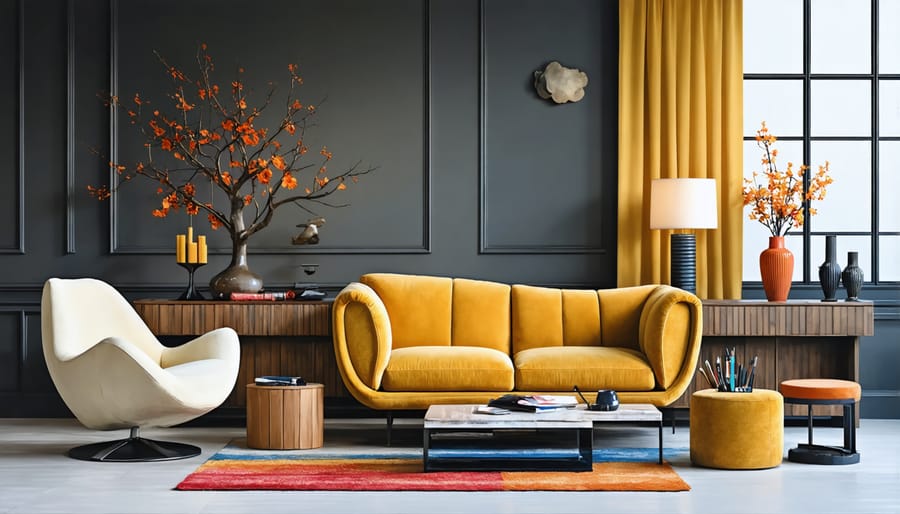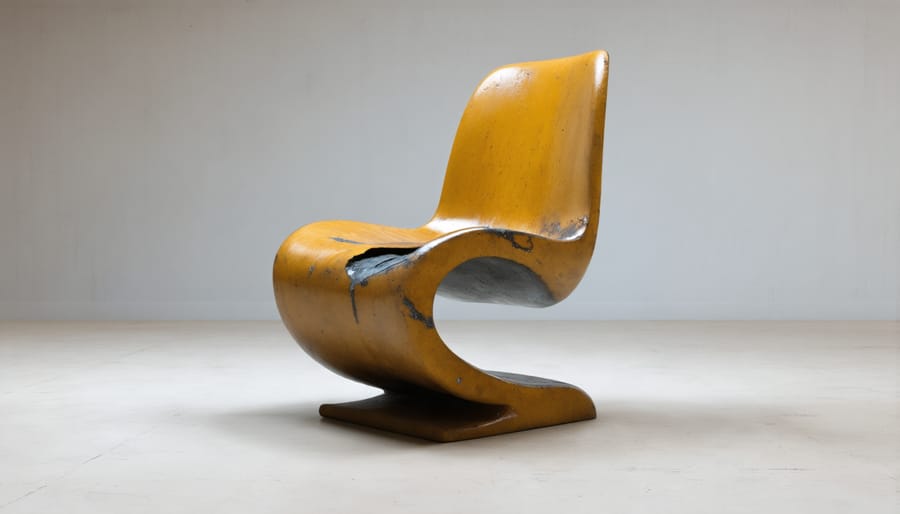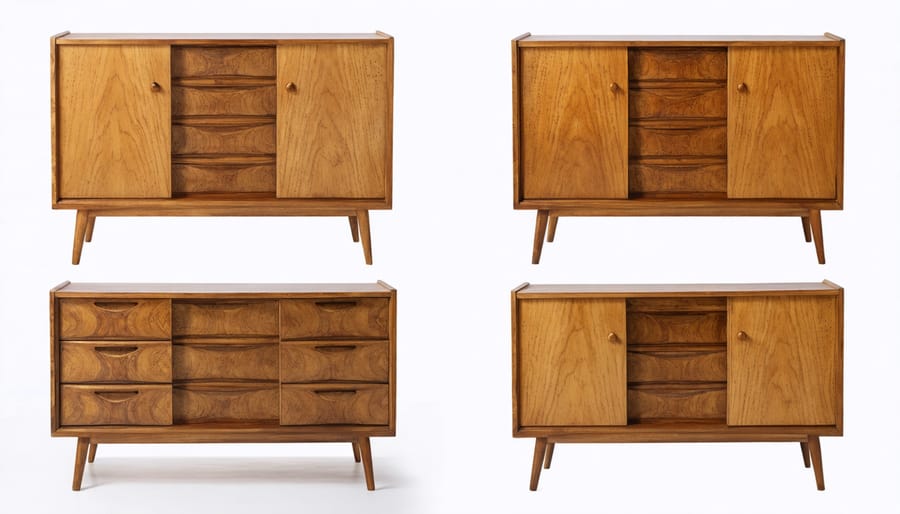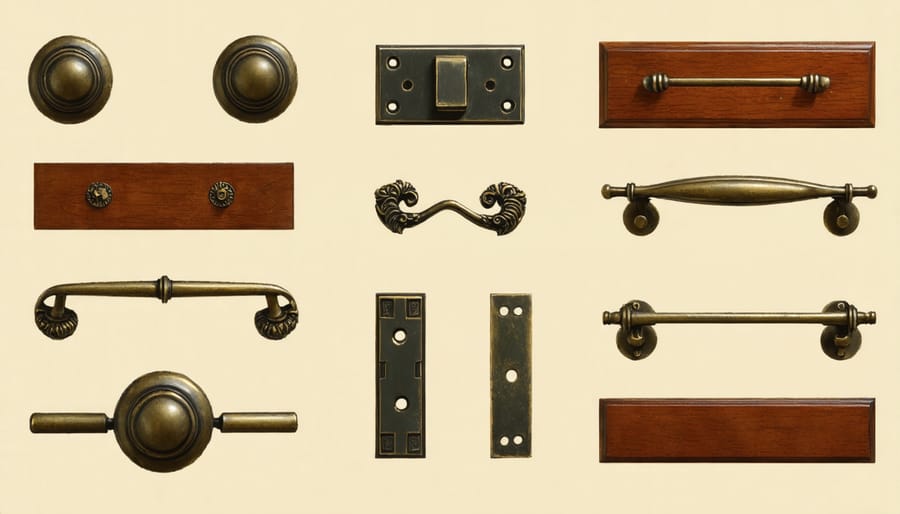
The bold, sculptural forms and innovative materials of 1970s modern furniture represent a pivotal moment in design history, where functionality merged with avant-garde aesthetics. From chrome-plated steel frames to molded plastic shells, these pieces revolutionized interior spaces with their groundbreaking modern restoration techniques and enduring appeal. Icons like Vladimir Kagan’s serpentine sofas and Verner Panton’s S-shaped chairs continue to influence contemporary design, commanding premium prices in today’s market. Whether adorning minimalist penthouses or eclectic living spaces, these statement pieces blend seamlessly with modern interiors while maintaining their distinctive character. Understanding the unique materials, construction methods, and preservation requirements of 70s furniture empowers owners to protect these valuable design investments for future generations.
Plastic and fiberglass furniture pieces from the 1970s often face distinct challenges that require specialized repair approaches. Common issues include yellowing of white fiberglass, stress cracks in molded chairs, and broken edges on plastic components. The good news is that most of these problems can be effectively addressed with modern restoration techniques.
For yellowed fiberglass surfaces, a professional-grade oxidation removal system can restore the original bright white appearance without damaging the material’s integrity. Small stress cracks in iconic pieces like the Eames shell chairs can be stabilized using specialized epoxy fillers that match the original material’s flexibility and strength.
Surface scratches on plastic furniture can often be buffed out using progressive polishing compounds, while deeper gouges may require fill-and-blend techniques. For structural repairs, modern two-part epoxy systems provide excellent bonding strength while maintaining period-correct aesthetics.
One particularly challenging issue is the deterioration of color-impregnated fiberglass, which was common in 70s furniture. These pieces require careful color matching and specialized UV-resistant coating systems to prevent further fading while maintaining authenticity.
Before attempting any repairs, it’s crucial to identify the specific type of plastic or fiberglass used, as different materials require different approaches. Professional restoration services can perform material testing to ensure the appropriate repair method is selected, helping preserve these valuable pieces of design history for future generations.

The distinctive wood veneer and laminate surfaces of 70s modern furniture often require special attention to restore their original beauty. When it comes to repairing wood veneer, understanding the difference between these materials is crucial for successful restoration.
For veneer repairs, start by carefully assessing any loose or damaged areas. Using a sharp utility knife, clean the edges of loose veneer and remove any deteriorated sections. Apply heat carefully with an iron on low setting through a damp cloth to soften old adhesive, making it easier to work with the material. High-quality wood glue, applied evenly with proper clamping pressure, ensures lasting repairs.
Laminate surfaces, common in many 70s pieces, require a different approach. Unlike veneer, laminate is synthetic and cannot be refinished through traditional sanding methods. Instead, focus on cleaning with appropriate solutions and addressing edge lifting with contact cement. For scratches, specialized laminate fill sticks matching the original color can work wonders.
Both materials benefit from preventive care: use coasters, avoid direct sunlight, and maintain consistent humidity levels. For deeper damage or particularly valuable pieces, professional restoration services can ensure the best results while preserving the furniture’s authentic character and value.
Remember to test any cleaning or repair products on an inconspicuous area first, and always work in a well-ventilated space when using adhesives or solvents.
Before beginning any restoration work on your 70s modern furniture, proper surface cleaning and preparation is essential for achieving professional results. Start by identifying the primary material of your piece, as different surfaces require specific cleaning approaches and professional restoration materials.
For wood surfaces, begin with a gentle dry cleaning using a soft microfiber cloth to remove loose dust and debris. Follow with a specialized wood cleaner appropriate for your finish type, whether it’s teak oil, polyurethane, or lacquer. Avoid using harsh chemicals or excessive water, which can damage vintage finishes.
Metal components, common in 70s furniture, should be cleaned with a mild solution of warm water and dish soap, then thoroughly dried to prevent oxidation. For chrome pieces, use a designated chrome cleaner to restore shine without scratching the surface.
Plastic and laminate surfaces, signature elements of modern 70s design, require gentle cleaning with a pH-neutral cleaner. Test any cleaning solution on an inconspicuous area first to ensure it won’t cause discoloration or damage.
For upholstered pieces, vacuum thoroughly using appropriate attachments to remove embedded dirt. Spot-clean stains using fabric-specific cleaners, working from the outside of the stain inward to prevent spreading. Allow surfaces to dry completely before proceeding with any repairs or refinishing work.
Remember that some vintage materials may be sensitive to modern cleaning products, so when in doubt, consult with a professional furniture restorer to preserve your piece’s authenticity and value.
Matching and refinishing the unique colors of 70s modern furniture requires both technical expertise and an artistic eye. The distinctive palette of this era, featuring rich oranges, deep browns, and vibrant teals, presents special challenges for restoration professionals and DIY enthusiasts alike.
Modern color-matching technology has revolutionized the restoration process. Using spectrophotometers and digital color analysis tools, experts can now precisely identify original paint and stain colors, even on weathered or faded surfaces. This technology, combined with traditional techniques like custom mixing and layering, ensures authentic results that maintain the furniture’s historical integrity.
For wood finishes, the process typically begins with careful cleaning and stripping of the existing finish. Many 70s pieces feature oil-based finishes that have developed a characteristic patina over time. Modern water-based alternatives can achieve similar results while being more environmentally friendly and easier to maintain. When matching wood tones, professionals often use a combination of stains and glazes to recreate the depth and warmth characteristic of the period.
For painted surfaces, modern acrylic and lacquer finishes offer superior durability while maintaining period-appropriate aesthetics. The key is building up thin layers to achieve the desired color depth and sheen. Many restoration experts recommend using UV-resistant finishes to prevent future fading and color shifts, especially important for preserving the bold hues typical of 70s furniture.
Texture matching is equally important as color. The subtle variations in original finishes, from high-gloss to matte, contribute significantly to the piece’s authenticity. Modern finishing techniques, including spray application and hand-rubbed methods, can accurately recreate these surface characteristics.
Success in color matching often depends on understanding the original manufacturing techniques. Many 70s furniture makers used proprietary finishing processes, and knowledge of these methods helps inform modern restoration approaches. Documentation and photography throughout the refinishing process ensure consistency and help maintain the piece’s value as a collector’s item.


When it comes to hardware on 70s modern furniture, authenticity is key to maintaining its value and aesthetic appeal. Original handles, hinges, and other metal components often show signs of wear or damage, but don’t despair – there are multiple solutions available.
For cabinet pulls and drawer handles, start by checking specialty vintage hardware suppliers who stock authentic 70s pieces. Many companies now reproduce period-correct hardware, offering near-identical matches to original pieces. Popular finishes from this era include brushed aluminum, chrome, and brass, with geometric shapes being particularly characteristic of the period.
If original hardware is salvageable, professional restoration can bring back its former glory. Light tarnishing often responds well to gentle cleaning with appropriate metal polish, while more severe oxidation may require professional intervention. For chrome pieces, re-plating services can restore the bright, reflective finish that defines many 70s designs.
When exact matches aren’t available, consider working with a custom metalworker who can replicate original pieces. While this option may be more expensive, it ensures perfect compatibility with existing mounting holes and maintains the furniture’s authentic appearance.
For structural hardware like hinges and drawer slides, modern equivalents often provide better functionality while remaining visually consistent. Many contemporary manufacturers produce hardware specifically designed to match vintage specifications, offering improved durability without compromising the piece’s period appearance.
Remember to document original hardware placement and keep all original pieces, even if damaged. These can serve as valuable reference points for replacements and may be useful for future restoration projects. When storing removed hardware, label each piece clearly to maintain the proper configuration for reassembly.
To preserve your cherished 70s modern furniture, understanding and controlling environmental factors is crucial. Sunlight exposure is particularly damaging to vintage pieces, causing fading and material degradation. Position your furniture away from direct sunlight or use UV-protective window films to minimize this risk.
Temperature and humidity fluctuations can severely impact wood and upholstery materials. Maintain consistent indoor conditions between 68-72°F (20-22°C) with relative humidity levels of 45-55%. Use dehumidifiers in damp areas and humidifiers in dry climates to protect against warping, cracking, or mold growth.
Air quality also plays a vital role in furniture preservation. Regular dusting with soft, clean cloths prevents particle buildup that can scratch surfaces. Avoid placing pieces near heating vents or air conditioning units, as these create localized climate variations that stress materials.
For leather upholstery common in 70s furniture, condition regularly to prevent drying and cracking. Wood pieces benefit from periodic polishing with appropriate products to maintain their protective finish. When storing furniture, use breathable covers rather than plastic, which can trap moisture and promote mildew growth.
Consider the placement of your furniture in relation to foot traffic and daily activities. Creating buffer zones around significant pieces helps prevent accidental damage while maintaining their visual impact in your space.
To maintain the timeless appeal of your 70s modern furniture, establish a regular maintenance routine based on the materials used. For wood pieces, dust weekly with a soft, lint-free cloth, and apply furniture polish every three months to protect the finish. Teak oil should be applied bi-annually to maintain the wood’s natural luster and prevent drying or cracking.
For chrome and metal components, wipe down monthly with a damp cloth and dry thoroughly to prevent oxidation. Apply a specialized metal polish quarterly to maintain shine and prevent tarnish. Pay special attention to joints and connections where moisture can accumulate.
Plastic and acrylic furniture requires gentle cleaning with mild soap and warm water every two weeks. Avoid abrasive cleaners that can scratch surfaces. For stubborn marks, use a plastic-specific cleaner and soft cloth. Keep these pieces away from direct sunlight to prevent yellowing and deterioration.
Upholstered items need regular vacuuming every two weeks to prevent dust accumulation. Treat stains immediately using appropriate fabric cleaners, and schedule professional cleaning annually. For leather pieces, clean with a leather conditioner every six months to prevent cracking and maintain suppleness.
Remember to check and tighten any loose screws or fittings quarterly, and inspect for signs of wear or damage during your regular cleaning routine. Proper maintenance not only preserves appearance but also extends the life of these valuable vintage pieces.
The preservation and proper maintenance of 70s modern furniture represents more than just caring for vintage pieces – it’s about safeguarding important design heritage for future generations. These iconic pieces, with their distinct aesthetics and innovative use of materials, deserve thoughtful restoration approaches that honor their original design while ensuring their longevity.
Successful restoration requires a delicate balance between preserving authenticity and addressing wear and tear. Whether dealing with chrome-plated steel, molded plastics, or exotic woods, each material demands specific expertise and appropriate restoration techniques. Regular maintenance, including proper cleaning, environmental control, and preventive care, can significantly extend the life of these pieces and maintain their value.
For collectors and enthusiasts, investing in professional restoration services when needed can make the difference between preserving a piece’s worth and inadvertently diminishing it through improper DIY attempts. The right restoration expert will understand not just the physical materials, but also the historical context and design principles that make 70s furniture unique.
As these pieces continue to gain appreciation in the modern design market, proper restoration and maintenance become increasingly crucial. Whether you’re a dedicated collector or simply appreciate the clean lines and bold statements of 70s modern furniture, implementing proper care routines and seeking professional help when necessary will ensure these design classics remain beautiful and functional for decades to come.